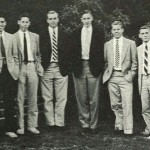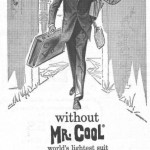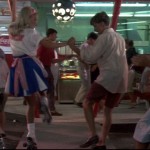
Years ago Tradsville personality “AldenPyle” started a thread at Ask Andy that included the above ad, which ran in the Yale Daily News in 1941. The ad touches on several themes we explored in our definitive rise and fall essay.
First off, notice the split between clothes for campus and clothes for town, which consists of oxford shirts, albeit with spread collars, and wingtips. The campus category, however, consists of sportcoats in Shetland and tweed, grey flannels “cut in your favorite university style,” buttondown shirts, argyle socks, and buckskin shoes. As I assert in the essay, the Ivy League Look clothing genre consisted of clothes for both city and campus, but it’s the campus look — in this case tweed jacket, grey flannels, buttondown oxford, foulard tie, argyle socks and bucks — that provided the lasting legacy, codified the “timeless” aspect of Ivy, and became the greatest influence on the clothing we wear today. The ad also expresses what I’ve called taste-driven natural selection. Macy’s sought to reach Yale students through their own newspaper, but assured them that the department store giant from New York understood the tastes of New Haven’s undergrads. The ad copy asserts that Macy’s knows Yale’s “traditions of dress,” and that its accessories are “correct” — not by the standards of Macy’s merchandisers, of course, but those of the students. Whether this was actually true is another matter, but Macy’s believed it could make the assertion, and that it needed to. There may have been some miscommunication between the copywriter and the illustrator, however, as the copy confidently states, “We know you don’t want jackets with exaggerated shoulders and fitted lines, so we bring you the traditionally Yale straight-hanging coat with natural shoulder,” and yet the illustration expresses straight lines a lot better than natural shoulder.
Finally, the ad is also interesting for showing that long before the heyday of widespread popularity, a big-city department store thought the Yale student market worth going after. There’s a world of difference between advertising in the Yale Daily News and sending road men to New Haven, as Macy’s did here in 1941, and selling elements of the look nationwide with campus-oriented ad copy, as Main Street retailers did years later. But Macy’s knew the clothes had to be right, and that it was the students who would make that call. The fact that Macy’s had to assure the Yale community that its wares were adequate, while a local such as J. Press presumably would not, shows the difference between local shops and the outsiders who wanted a piece of the pie.— CC










When I think of the Macy’s of today, and the clothing and furnishings it offers to men, I find it hard to believe that what is described above (“tailor-made to your specifications”, even!) ever really happened.
The inflation calculator maps that $28.50 for a “campus” sport coat in “IMPORTED Shetland and Tweed” to just shy of $440 in today’s money.
That’s a bargain price, I reckon. Anyone know what such a coat would have gone for at Brooks Bros. back then?
@Cameron Adult jackets were $45.00-$58.00 in 1940.
Update 1942 Brooks 6th floor college shop country jackets $35.00-$38.00
The copywriter sure “knew” Yale!
Their Club Room collection was a decent entry level collection for a young fellow wasn’t it?
Was that really 5 years ago? Wow, time flies.
Looking back, I think I still agree with the gist of the stuff I wrote in that thread. Probably, I overemphasized the American-ness of the sack suit. Rather, the Brooks sack suit of the 1890’s was probably an example of a more general and trans-Atlantic adoption of the lounge suit for business wear. The unshaped, natural shoulder nature was just the primitive form of this suit. The padded shoulders, puffed out chest, pleats and nipped waist were basically developed on Saville Row during the Edwardian era and I think were seen as Englishisms as they spread into the USA in the 1910’s and 20’s. People continued to wear the old-style suits during this period (maybe particularly in New England) and young people, students and post-collegiate, wore them, perhaps as starter suits.
The spread of English country wear, tweed sportcoats, blazers and flannels to American upper-crust society post-dated the Saville Row tailoring innovations and were adopted initially in their original Englishy pleated, darted form. It does seem that there was a trend toward recutting them in traditional form (i.e. in the form of the Brooks style sack suits) that occurred on Ivy League campuses in the late 1930s. It seems like this trend gelled on campus in the late 40’s into what we could call the Ivy look.
Another “smoking gun” that before Ivy cycle of 50s/60s Ivy clothes were campus look.
The year is important: is 1941.
In 1941 the average fashion was completely different from Ivy silhouette.
Broad shoulders,double breasteds,waist marked..in comparison 30s suits were more clean!
In campus the fashion is totally different,is a world apart.
Is clear to me that sellers are not selling Ivy suits using the campus like a advertising lure.
They sell a particular type of clothes for campus and students.
Carmelo sez “In campus the fashion is totally different,is a world apart.”
This seems like a bit of an exaggeration. Its clear that in the 1930’s, the NY media viewed Ivy League (esp. Princeton and Yale) students as fashion leaders to be emulated. At the same time, scanning the student newspapers, its also clear that NY makers marketed the fashions of the day (peak lapel, double breasted, big shoulders and all) to Ivy League students.
But it is clear that those students viewed themselves as having a distinct style over the 30’s,and that style probably featured less constructed jackets than mainstream Depresssion era fashion. Moreover, the idea of the ivy league style as featuring British country wear but with natural shouldered, undarted jackets, unpleated pants, buttondown shirts, penny loafers etc (i.e. most of the canonical items) did come into being there during the late 1930’s (while the fashion industry was doing something else). Probably, the more modern form solidified at JPress in the late 1940’s.
,
– Carmelo “Another“smoking gun that before Ivy cycle of 50s/60s Ivy clothes were campus look.
Is clear to me that sellers are not selling Ivy suits using the campus like a advertising lure.
They sell a particular type of clothes for campus and students.”
Appreciate you saying this. It is something Americans have been saying since the dawn of the internet
but all we get in response is that “College and Ivy is the hook to sell to poor insecure kids.”